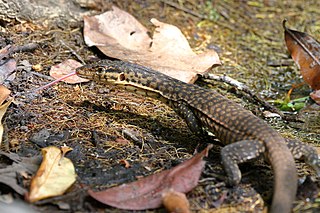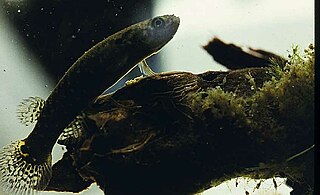
Gorillas are herbivorous, predominantly ground-dwelling great apes that inhabit the tropical forests of equatorial Africa. The genus Gorilla is divided into two species: the eastern gorilla and the western gorilla, and either four or five subspecies. The DNA of gorillas is highly similar to that of humans, from 95 to 99% depending on what is included, and they are the next closest living relatives to humans after chimpanzees and bonobos.

An embryo is the initial stage of development for a multicellular organism. In organisms that reproduce sexually, embryonic development is the part of the life cycle that begins just after fertilization of the female egg cell by the male sperm cell. The resulting fusion of these two cells produces a single-celled zygote that undergoes many cell divisions that produce cells known as blastomeres. The blastomeres are arranged as a solid ball that when reaching a certain size, called a morula, takes in fluid to create a cavity called a blastocoel. The structure is then termed a blastula, or a blastocyst in mammals.

Biodiversity is the variety and variability of life on Earth. It can be measured on various levels. There is for example genetic variability, species diversity, ecosystem diversity and phylogenetic diversity. Diversity is not distributed evenly on Earth. It is greater in the tropics as a result of the warm climate and high primary productivity in the region near the equator. Tropical forest ecosystems cover less than one-fifth of Earth's terrestrial area and contain about 50% of the world's species. There are latitudinal gradients in species diversity for both marine and terrestrial taxa.

Conservation biology is the study of the conservation of nature and of Earth's biodiversity with the aim of protecting species, their habitats, and ecosystems from excessive rates of extinction and the erosion of biotic interactions. It is an interdisciplinary subject drawing on natural and social sciences, and the practice of natural resource management.

The western lowland gorilla is one of two Critically Endangered subspecies of the western gorilla that lives in montane, primary and secondary forest and lowland swampland in central Africa in Angola, Cameroon, Central African Republic, Republic of the Congo, Democratic Republic of the Congo, Equatorial Guinea and Gabon. It is the nominate subspecies of the western gorilla, and the smallest of the four gorilla subspecies.

Captive breeding, also known as captive propagation, is the process of keeping plants or animals in controlled environments, such as wildlife reserves, zoos, botanic gardens, and other conservation facilities. It is sometimes employed to help species that are being threatened by the effects of human activities such as climate change, habitat loss, fragmentation, overhunting or fishing, pollution, predation, disease, and parasitism.

Animal captivity is the confinement of domestic and wild animals. More specifically, animals that are held by humans and prevented from escaping are said to be in captivity. The term animal captivity is usually applied to wild animals that are held in confinement, but this term may also be used generally to describe the keeping of domesticated animals such as livestock or pets. This may include, for example, animals in farms, private homes, zoos, and laboratories. Animal captivity may be categorized according to the particular motives, objectives, and conditions of the confinement.

Behavioral enrichment is an animal husbandry principle that seeks to enhance the quality of captive animal care by identifying and providing the environmental stimuli necessary for optimal psychological and physiological well-being. Enrichment can either be active or passive, depending on whether it requires direct contact between the animal and the enrichment. A variety of enrichment techniques are used to create desired outcomes similar to an animal's individual and species' history. Each of the techniques used is intended to stimulate the animal's senses similarly to how they would be activated in the wild. Provided enrichment may be seen in the form of auditory, olfactory, habitat factors, food, research projects, training, and objects.

Several species of Malagasy hippopotamus lived on the island of Madagascar but are now believed to be extinct. The animals were very similar to the extant hippopotamus and pygmy hippopotamus. The fossil record suggests that at least one species of hippopotamus lived until about 1,000 years ago and other evidence suggests that the species may have survived until much more recently. The taxonomy of these animals is not resolved and not widely studied.
Genetic erosion is a process where the limited gene pool of an endangered species diminishes even more when reproductive individuals die off before reproducing with others in their endangered low population. The term is sometimes used in a narrow sense, such as when describing the loss of particular alleles or genes, as well as being used more broadly, as when referring to the loss of a phenotype or whole species.

Oxygyne is a genus of plant in family Burmanniaceae, first described as a genus in 1906. It has a highly disjunct distribution, found in Japan in East Asia and in Cameroon in Central Africa. The genus is composed by six species which are all mycoheterotrophic, are devoid of functional leaves and do not photosynthesise.

An endangered species is a species that is very likely to become extinct in the near future, either worldwide or in a particular political jurisdiction. Endangered species may be at risk due to factors such as habitat loss, poaching, invasive species, and climate change. The International Union for Conservation of Nature (IUCN) Red List lists the global conservation status of many species, and various other agencies assess the status of species within particular areas. Many nations have laws that protect conservation-reliant species which, for example, forbid hunting, restrict land development, or create protected areas. Some endangered species are the target of extensive conservation efforts such as captive breeding and habitat restoration.

Defaunation is the global, local, or functional extinction of animal populations or species from ecological communities. The growth of the human population, combined with advances in harvesting technologies, has led to more intense and efficient exploitation of the environment. This has resulted in the depletion of large vertebrates from ecological communities, creating what has been termed "empty forest". Defaunation differs from extinction; it includes both the disappearance of species and declines in abundance. Defaunation effects were first implied at the Symposium of Plant-Animal Interactions at the University of Campinas, Brazil in 1988 in the context of Neotropical forests. Since then, the term has gained broader usage in conservation biology as a global phenomenon.

The Cuban crocodile is a small-medium species of crocodile endemic to Cuba. Typical length is 2.1–2.3 m (6.9–7.5 ft) and typical weight 70–80 kg (150–180 lb). Large males can reach as much as 3.5 m (11 ft) in length and weigh more than 215 kg (474 lb). Despite its smaller size, it is a highly aggressive animal, and potentially dangerous to humans.

Mitchell's water monitor is a semiaquatic species of monitor lizard in the family Varanidae. The species is native to Australia. The species is native to the Northern regions of Australia, and is on IUCN's Red List as a critically endangered species. They can be distinguished by the orange or yellow stripes along their neck and dark spots along their back. They are mainly carnivorous, and eat small prey such as lizard, birds, and insects.

Ginkgo yimaensis is an extinct ginkgo species in the family Ginkgoaceae. It is a gymnosperm, first described by Zhou and Zhang.

Biodiversity loss happens when plant or animal species disappear completely from Earth (extinction) or when there is a decrease or disappearance of species in a specific area. Biodiversity loss means that there is a reduction in biological diversity in a given area. The decrease can be temporary or permanent. It is temporary if the damage that led to the loss is reversible in time, for example through ecological restoration. If this is not possible, then the decrease is permanent. The cause of most of the biodiversity loss is, generally speaking, human activities that push the planetary boundaries too far. These activities include habitat destruction and land use intensification. Further problem areas are air and water pollution, over-exploitation, invasive species and climate change.

The winner and loser effect is an aggression phenomenon in which the winner effect is the increased probability that an animal will win future aggressive interactions after experiencing previous wins, while the loser effect is the increased probability that an animal will lose future aggressive interactions after experiencing previous losses. Overall these effects can either increase or decrease an animals aggressive behaviour, depending on what effect affects the species of concern. Animals such as Agkistrodon contortrix, Rivulus marmoratus, and Sula nebouxii show either both or one of these effects.
Digital sequence information (DSI) is a placeholder term used in international policy fora, particularly the Convention on Biological Diversity (CBD), to refer to data derived from de-materialized genetic resources. The 2018 Ad Hoc Technical Expert Group on DSI reached consensus that the term was "not appropriate". Nevertheless, the term is generally agreed to include nucleic acid sequence data, and may be construed to include other data types derived from or linked to dematerialized genetic resources, including, for example, protein sequence data. The appropriateness and meaning of this term remain controversial as evidenced by its continued placeholder status, post the 15th Conference of the Parties to the CBD. DSI is crucial to research in a wide range of contexts, including public health, medicine, biodiversity, plant and animal breeding, and evolution research.
Plants, People, Planet is a bimonthly peer-reviewed scientific journal which focuses on plant science, and the links between plant science and society in particular. It was established in 2018 by the New Phytologist Foundation, and is published by Wiley-Blackwell on their behalf.

















